continued:
A Little Story
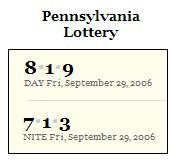
So make it one for my baby (8/19)
And one more for the road (7/13).
8/19:
7/13:

So make it one for my baby (8/19)
And one more for the road (7/13).
8/19:
7/13:
(Rosh Hashanah began at sundown September 22; Yom Kippur begins at sundown October 1. —holidays.net)
"Today comes more evidence of the left's painful struggle to deal with its diminished standing and repeated rejection at the polls. In the subscription-required Why Voters Like Values, [New York] Times columnist Judith Warner claims that "the Christian right's ability to stir voter passions is based not on values, but on psychology." Warner describes having bravely gone inside the belly of the conservative beast, recently attending a Values Voters Summit in DC, and declaring it "imbued with so much intolerance and hate." This is presumably in contrast with liberal love-ins, where Bush & Co. are regularly depicted as liars, murderers, Hitlers, etc.
She later describes a schadenfreude-provoking scene of the day after Kerry's 2004 defeat, picking through the rubble with Harvard psychology professor emeritus, Jerome Kagan, who tried to console Warner and presumably himself. As she describes it:
"Our conversation drifted to the Republicans' 'values' [note scare quotes] agenda, and Kagan's belief that values sell because they're an antidote to the endemic mental health problem of our time: depression.
"'Humans demand that there be a clear right and wrong,' he said. 'You've got to believe that the track you've taken is the right track. You get depressed if you're not certain as to what it is you're supposed to be doing or what's right and wrong in the world."
"People need to divide the world into good and evil, us and them, Kagan continued. To do otherwise– to entertain the possibility that life is not black and white, but variously shaded in gray– is perhaps more honest, rational and decent. But it's also, psychically, a recipe for disaster."
Got it? Liberalism is "more honest, rational and decent" than conservativism, but that's just not what the benighted public wants. They're looking for political Prozac, a Manichean worldview they can cling to, and that's what conservatism cunningly offers.
Less controversial values are provided by yesterday evening's Pennsylvania lottery— namely, the values 4, 5, and 6.
For a discussion of these values under the guise of musical intervals, see Professor Kagan again, in a paper (pdf) he wrote with Marcel R. Zentner, "Infants' Perception of Consonance and Dissonance in Music" (Infant Behavior & Development, Vol. 21, No. 3, 1998):
Adults judge as most consonant either the octave (difference of 12 semitones) [or the unison, difference of 0 semitones], the fifth (7 semitones), or the major third (4 semitones).
Illustration (see also yesterday evening):
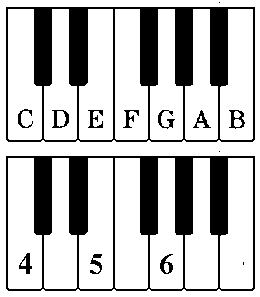
Notes and frequency ratios
The paper discusses consonant intervals
as an example of alleged
"perceptual universals."
Related material on universals
suitable for today, the Feast of
St. Michael and All Angels:
Shining Forth and
Midsummer Eve's Dream.
The material in Shining Forth
is also related, tangentially, to the
following presentation of the
Warner "values" essay
in today's online New York Times:

The above three Times items,
taken together, suggest that
those in search of "values"
should consult Betty Suarez:
Click on picture for further details.
Today’s evening lottery number in the state of Grace was 546… or, digit by digit,
Grace
Background on today’s noon entry:
Background on today’s morning entry:
Note the… description
of Christmas Eve 1900,
and the remark that
“Ici, le jour, c’est comme
dans une église.”
| Visitor | Page Visited |
| Macau | /home.aspx?user=m759… |
| Referrer | Time |
| search.yahoo.com… |
9/28/2006 11:34 AM |
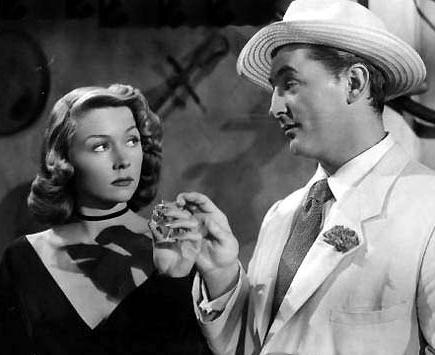
Halloran: You don’t want that junk.
Diamonds would only
cheapen you.
Margie: Yeah. But what a way
to be cheapened.
| From the diary of John Baez: September 22, 2006… Meanwhile, the mystics beckon:
September 23, 2006I’m going up to San Rafael (near the Bay in Northern California) to visit my college pal Bruce Smith and his family. I’ll be back on Wednesday the 27th, just in time to start teaching the next day. |
A check on the Rumi quote yields
this, on a culinary organization:
|
“Out beyond rightdoing and wrongdoing there is a field. I’ll meet you there.”
This is the starting place of good spirit for relationship healing and building prescribed centuries ago in the Middle East by Muslim Sufi teacher and mystic, Jelaluddin Rumi (1207-1273). Even earlier, the Psalmists knew such a meeting place of adversaries was needed, sacred and blessed: |
A Field and a Table:

From “Communications Toolbox”
at MathWorks.com
For more on this field
in a different context, see
Generating the Octad Generator
and
“Putting Descartes Before Dehors”
in my own diary for December 2003.

Descartes

Après l’Office à l’Église
de la Sainte-Trinité, Noël 1890
(After the Service at Holy Trinity Church,
Christmas 1890), Jean Béraud
Let us pray to the Holy Trinity that
San Rafael guides the teaching of John Baez
this year. For related material on theology
and the presence of enemies, see Log24 on
the (former) Feast of San Rafael, 2003.
| From Eliot’s “Ash Wednesday“– “Prophesy to the wind, 
From The Man in the High Castle: “Juliana said, ‘Oracle, why did you write The Grasshopper Lies Heavy? What are we supposed to learn?’ ‘You have a disconcertingly superstitious way of phrasing your question,’ Hawthorne said. But he had squatted down to witness the coin throwing. ‘Go ahead,’ he said; he handed her three Chinese brass coins with holes in the center. ‘I generally use these.’
She began throwing the coins; she felt calm and very much herself. Hawthorne wrote down her lines for her. When she had thrown the coins six times, he gazed down and said: ‘Sun at the top. Tui at the bottom. Empty in the center.’
‘Do you know what hexagram that is?’ she said. ‘Without using the chart?’ ‘Yes,’ Hawthorne said. ‘It’s Chung Fu,’ Juliana said. ‘Inner Truth. I know without using the chart, too. And I know what it means.'”

Our Lady of
Judgment Day
“One of the illusions is that the present hour is not the critical, decisive hour. Write it on your heart that every day is the best day in the year. No man has learned anything rightly until he knows that every day is Doomsday.”
— Emerson, Ch. VII, “Works and Days,” in The Complete Works of Ralph Waldo Emerson, Vol. VII, Society and Solitude (1870) |
|
“A corpse will be — Under the Volcano,
“It has a ghastly familiarity,
like a half-forgotten dream.” — Poppy (Gene Tierney) in |
|
Temptation
|
|
“We tell ourselves stories in order to live…. We interpret what we see, select the most workable of multiple choices. We live entirely, especially if we are writers, by the imposition of a narrative line upon disparate images, by the ‘ideas‘ with which we have learned to freeze the shifting phantasmagoria which is our actual experience. Or at least we do for a while. I am talking here about a time when I began to doubt the premises of all the stories I had ever told myself, a common condition but one I found troubling.” From Patrick Vert, “There are plenty of anecdotes to highlight the personal, phenomenological experience of railway passage… … a unique study on phantasmagoria and the history of imagination. The word originates [in] light-projection, the so-called ghost-shows of the early 19th century…. … thought becomes a phantasmagorical process, a spectral, representative location for the personal imagination that had been marginalized by scientific rationalism…. This phantasmagoria became more mediated over time…. Perception became increasingly visually oriented…. As this occurred, a narrative formed to encapsulate the phenomenology of it all….” For such a narrative, see |
| From a Christian fairy tale:
Aslan’s last words come at the end of The Last Battle: ‘There was a real railway accident […] Your father and mother and all of you are–as you used to call it in the Shadow-Lands–dead. The term is over: the holidays have begun. The dream is ended: this is the morning.’…. Aslan is given the last word in these quiet but emphatic lines. He is the ultimate arbiter of reality: “‘There was a real railway accident.'” Plato, in addition to the Christian tradition, lies behind the closing chapters of The Last Battle. The references here to the Shadowlands and to the dream refer back to an earlier explanation by Digory, now the Lord Digory: “[…] that was not the real Narnia. That had a beginning and an end. It was only a shadow or a copy of the real Narnia, which has always been here and always will be here: just as our world, England and all, is only a shadow or copy of something in Aslan’s real world. [….] Of course it is different; as different as a real thing is from a shadow or as waking life is from a dream. […] It’s all in Plato, all in Plato: bless me, what do they teach them at these schools!” |
| “I was reading Durant’s section on Plato, struggling to understand his theory of the ideal Forms that lay in inviolable perfection out beyond the phantasmagoria. (That was the first, and I think the last, time that I encountered that word.)” |
Whether any of the above will be of use in comforting the families of those killed in yesterday morning’s train wreck in Germany is not clear. Pope Benedict XVI, like C. S. Lewis, seems to think Greek philosophy may be of some use to those dealing with train wrecks:
| “Modifying the first verse of the Book of Genesis, the first verse of the whole Bible, John began the prologue of his Gospel with the words: ‘In the beginning was the logos.‘ This is the very word used by the emperor: God acts, syn logo, with logos. Logos means both reason and word– a reason which is creative and capable of self-communication, precisely as reason. John thus spoke the final word on the biblical concept of God, and in this word all the often toilsome and tortuous threads of biblical faith find their culmination and synthesis. In the beginning was the logos, and the logos is God, says the Evangelist.”
— Remarks of the Pope at the University of Regensburg on Sept. 12, 2006 |
The Grace of Accuracy
In this morning's New York Times:

The Times describes yesterday's
memorial to Cy Feuer,
producer, notably, of the 1972
film version of "Cabaret"–
"Joel Grey sang 'Willkommen….'"
Related material:
a Log24 entry
from October 29, 2002–
|
Our Judeo-Christian Heritage: Two Sides of the Same Coin
|
— and Echoes
(August 11, 2006).
The New York Times on Sven Nykvist,
a cinematographer who died on Wednesday:
"Pray for the grace of accuracy
Vermeer gave to the sun's illumination…."
— "Epilogue," by Robert Lowell,
in Day by Day, 1977
For further remarks on light,
see Shining Forth as well as
Tombstone (from May 17,
the date of Feuer's death).
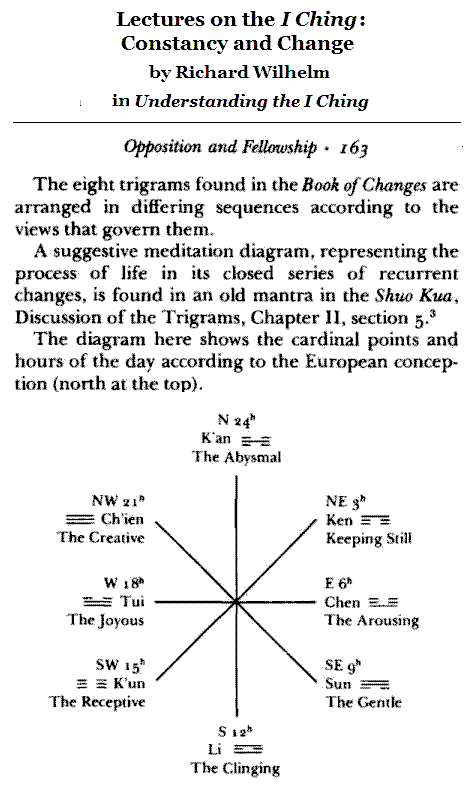
A related symbol, in memory of
two-time Academy Award winning
cinematographer Sven Nykvist,
who died yesterday:

(See Why Me?, Show Business,
and the cover of the DVD of
an Ingmar Bergman trilogy
photographed by Nykvist.)
Public Space
"… the Danish cartoons crisis last March showed 'two world views colliding in public space with no common point of reference.'"
— George Carey, Archbishop of Canterbury from 1991 to 2002, quoted in today's London Times.
Related material:
Geometry and Christianity
(Google search yielding
"about 1,540,000" results)
Geometry and Islam
(Google search yielding
"about 1,580,000" results)

A Public Space

— Motto of
Plato's Academy
|
If we replace the Chinese word "I" (change, transformation) with the word "permutation," the relevance of Western mathematics (which some might call "the Logos") to the I Ching ("Changes Classic") beomes apparent.
Related material:
Hitler's Still Point, Jung's Imago, Solomon's Cube, Geometry of the I Ching, and Globe Award. |
For the relevance of Plato to
Islam, see David Wade's
Pattern in Islamic Art
and a Google search on
Plato and Islam
("about 1,680,000" results).
— Heraclitus of Ephesus, about 500 B.C.
For a Dark Lady,
Soledad O’Brien,
Who Turns 40 Today:
Jerezana, by Paco de Lucia
(Requires RealPlayer and broadband)
From a 1967 album.
For a more recent look at de Lucia,
see his Cositas Buenas video
(wmv format) at flamenco-world.com.
Taking Christ to the Movies,
by Anna Megill, Princeton ’06
Related material:
“Prepare for the Weirdness.”
— Hunter S. Thompson
(see entry of Sept. 17,
At Midnight),
and
NBC’s “Crazy Christians” Show
(or, “Taking Christ to Studio 60“)
10 PM ET tonight on NBC.
| Excerpts from Log 24, January 18, 2004: A Living Church "Plato has told you a truth; but Plato is dead. Shakespeare has startled you with an image; but Shakespeare will not startle you with any more. But imagine what it would be to live with such men still living. To know that Plato might break out with an original lecture to-morrow, or that at any moment Shakespeare might shatter everything with a single song. The man who lives in contact with what he believes to be a living Church is a man always expecting to meet Plato and Shakespeare to-morrow at breakfast. He is always expecting to see some truth that he has never seen before." — G. K. Chesterton, Orthodoxy C. P. Snow on G. H. Hardy in the foreword to A Mathematician's Apology: "… he had another favourite entertainment…." … If, as Chesterton might surmise, he… met Plato and Shakespeare in Heaven, the former might discuss with him the eternal Platonic form of the number 17*, while the latter might offer…. * Footnote of 9/18/06: For the Platonic form of 17, see Feast of the Triumph of the Cross (9/14/06) and Medal (9/15/06). |
A Living Church,
continued…
Related material:
|
ON 6-6-6 —
"Seamus Davey-Fitzpatrick stars in a scene from the R-rated movie 'The Omen.' An official of the Australian bishops conference took on the superstition surrounding the movie's release date of June 6, 2006, noting that 'I take evil far too seriously to think "The Omen" is telling me anything realistic or important.'" (CNS/20th Century Fox) |
and
At Midnight
“At midnight
on the Emperor’s pavement flit
Flames that no faggot feeds,
nor steel has lit,
Nor storm disturbs, flames
begotten of flame,
Where blood-begotten spirits come
And all complexities of fury leave,
Dying into a dance,
An agony of trance,
An agony of flame that cannot
singe a sleeve.”
— From Byzantium, by
William Butler Yeats
“The only hope, or else despair
Lies in the choice of pyre or pyre–
To be redeemed from fire by fire.”
— From Four Quartets, by
Thomas Stearns Eliot
“Look around you. There is an eerie sense of Panic in the air, a silent Fear and Uncertainty that comes with once reliable faiths and truths and solid Institutions that are no longer safe to believe in…”
— Prepare for the Weirdness, by Hunter S. Thompson, quoted in a sermon for Pentecost Sunday, 2005
“If you passed, you got to live, and if you failed you were burned alive on a pyre that’s now the Transgender Studies Building.”
— Baccalaureate address at the interfaith worship service, Princeton University, on Pentecost Sunday, June 4, 2006
Review:
“At midnight on the Emperor’s pavement….”
The Pope in
Plato's Cave
Those who find the Pope's recent remarks (see the previous entry) on a Byzantine emperor lacking in literary depth may consult the writings of William Butler Yeats on Byzantium quoted in Log24 entries of February 14-16, 2003. Those entries also refer to a modern version of Plato's cave– the movie theater– and the film "The Recruit." See also a more recent Log24 discussion of that film:
This supplies a different illustration
of the previous entry's conclusion:
"Nine is a very powerful
Nordic number."
Pandora's Box
Part I:
The Pandora Cross
— Rosalind Krauss in "Grids"

Part II:
The Opening
Remarks by the Pope on Sept. 12,
as reported by the Vatican:
Faith, Reason, and the University:
Memories and Reflections
For the result of
the Pope's remarks, see
a transcript of
yesterday's Google News
and the following
from BBC today:

Click to enlarge the screenshot.
Part III:
Hope
"In September [2005], she had a private audience with Pope Benedict XVI at Castel Gandolfo, his summer residence outside Rome. She had criticized John Paul II for making overtures to Muslims, and for not condemning terrorism heartily enough, but she has hopes for Joseph Ratzinger."
For further details, see yesterday's Log24.
Part IV:
The Sibyl's Song
— From The Magic Circle,
a spiritual narrative
by Katherine Neville
For more on "the long-mute voice
of the past," on "darkness beneath
the volcano," and on uncorking,
see Glory Season and Harrowing.
Related material from
Log24 on Dec. 2, 2005:
Benedict XVI, before he became Pope:

and a related
Christian symbol,

the Greek Cross
(adapted from
Ad Reinhardt).
Moral of the Pandora Cross:
"Nine is a very powerful Nordic number."
— Katherine Neville in The Magic Circle…
quoted in The Nine, a Log24 entry
for Hermann Weyl's birthday,
November 9, 2004.

In memory of
journalist Oriana Fallaci,
who died last night:
"In September [2005], she had a private audience with Pope Benedict XVI at Castel Gandolfo, his summer residence outside Rome. She had criticized John Paul II for making overtures to Muslims, and for not condemning terrorism heartily enough, but she has hopes for Joseph Ratzinger. (The meeting was something of a scandal in Italy, since Fallaci has always said that she is an atheist; more recently, she has called herself a 'Christian atheist,' out of respect for Italy's Catholic tradition.) Last December, the Italian government presented her with a gold medal for 'cultural achievement.'"
For more on the "medal"
pictured above,
see Log24 entries of
September 13 and 14
and of D-Day 2006.
Update of 4 PM Sept. 15–
Click for further details:
"She has hopes
for Joseph Ratzinger…."
and the birthday of
an expert on primitive roots,
the late I. M. Vinogradov.
Happy birthday.
Click on pictures
for further details.
The Krauss Cross
"If we open any tract– Plastic Art and Pure Plastic Art or The Non-Objective World, for instance– we will find that Mondrian and Malevich are not discussing canvas or pigment or graphite or any other form of matter. They are talking about Being or Mind or Spirit. From their point of view, the grid is a staircase to the Universal, and they are not interested in what happens below in the Concrete.
Or, to take a more up-to-date example, we could think about Ad Reinhardt who, despite his repeated insistence that 'Art is art,' ended up by painting a series of black nine-square grids in which the motif that inescapably emerges is a Greek cross. There is no painter in the West who can be unaware of the symbolic power of the cruciform shape and the Pandora's box of spiritual reference that is opened once one uses it."
Rebecca Goldstein on
Mathematics and Narrative:
"I don't write exclusively on Jewish themes or about Jewish characters. My collection of short stories, Strange Attractors, contained nine pieces, five of which were, to some degree, Jewish, and this ratio has provided me with a precise mathematical answer (for me, still the best kind of answer) to the question of whether I am a Jewish writer. I am five-ninths a Jewish writer."
Jacques Maritain,
October 1941:
"The passion of Israel
today is taking on
more and more distinctly
the form of the Cross."
E. L. Doctorow,
City of God:
"In the garden of Adding,
Live Even and Odd."
Octobers for Fest
In memory of Joachim Fest, a noted biographer of Hitler who died on 9/11 at age 79–
A link from 5/27, 2005 (a date mentioned in Monday's Log24 9/11 entry):
A search on this inelegant phrase from Sartre's Being and Nothingness leads, surprisingly, to remarks by the Catholic philosopher Jacques Maritain said to have been published in the month of October in the fateful year 1941.
According to Telegraph.co.uk today, Fest was "the most celebrated historian and the most distinguished journalist of the post-war generation in Germany."
The Telegraph says he
"aroused the envy of professorial rivals, none of whom could match the incisive elegance of his writing. Equally important was his flair for controversy. He was determined to prevent the wrong lessons being drawn from the past by the Left-wing establishment that had dominated German intellectual life since the 1960s.
Conservative in politics and Catholic by upbringing, Fest stood out among his contemporaries for his rejection of the influence of the Marxist sociologists of the Frankfurt school on the historiography of the Third Reich. Fest saw the Nazi phenomenon not as a product of capitalism, but as a moral catastrophe, made possible by the abdication of responsibility on the part of educated Germans."
For a view of Christian politics closer to that of the Frankfurt school, see a review by Charles Isherwood in the 9/11 New York Times of a play, "The Man Himself."
Related material:
A Log24 entry
from October 29, 2002:
|
Our Judeo-Christian Heritage: Two Sides of the Same Coin
|
and Echoes
(August 11, 2006).
A Sermon for Sartre
A sequel to
Les Mots:
Les Nombres
“Words and numbers
are of equal value,
for, in the
cloak of knowledge,
one is warp
and the other woof.”
— The princesses
Rhyme and Reason
in The Phantom Tollbooth,
by Norton Juster, 1961
| Lotteries 9/11/06 |
Midday |
Evening |
| NY | 394 | 628 |
| PA | 527 | 916 |
“Time and chance
happeneth to them all.”
— Ecclesiastes 9:11
The numbers may be regarded
as coordinates in a map
of one spatial dimension
(a road dimension:
394 – Chautauqua, NY)
and of three
temporal dimensions
(birthday dimension 6/28,
Sartre dimension 5/27,
religious dimension 9/16).
This interpretation is of course
rather arbitrary, but so are most
interpretations.
Related material:
Sontag and Sartre this morning
and Sontag on Sunday.
Update of 1:29 AM 9/12:

“HASS-D”– Click here.
Sontag’s Sermon
continued from yesterday
“My image of myself since age 3 or 4– the genius-schmuck. I allow one to pay off the other. Develop relationships to satisfy principally one or the other….
Sartre (cf. ‘Les Mots’) the only other person I know of who had this ‘certainty’ of genius. Living already a posthumous life, even as a childhood. (The childhood of a famous man.)
A kind of
Sartre was very ugly– and knew it. So he didn’t have to develop ‘the schmuck’ to pay off the others for being ‘the genius.’ Nature had taken care of the problem for him. He didn’t have to invent a cause of failure or rejection by others. As I did, by making myself ‘stupid’ in personal relations. (For ‘stupid,’ also read ‘blind.’)”
— Susan Sontag in The New York Times Magazine yesterday
Meanwhile, back at MIT:

Doonesbury 9/11
Related material
from MIT’s School of
Humanities, Arts,
and Social Sciences
(SHASS),

“‘For the modern post-religious man,’ Susan Sontag wrote in a 1961 essay, ‘the religious museum, like the world of the modern spectator of art, is without walls; he can pick and choose as he likes, and be committed to nothing except his own reverent spectatorship.'”
— “The Moralist,” by Scott McLemee, The Boston Globe, July 16, 2006
The last words from the people in the towers and on the planes, over and over again, were ‘I love you.’ Over and over again, the message was the same, ‘I love you.’ …. Perhaps this is the loudest chorus from The Rock: we are learning just how powerful love really is, even in the face of death.”ART WARS
continued:
Sources:
This morning’s Log24 entry,
today’s New York Times Magazine,
and today’s Doonesbury.
Related material:
My Life among the Deathworks:
Illustrations of the
Aesthetics of Authority,
by Philip Rieff,
Sontag’s ex-husband.
See also Nicole Kidman in
the 2004 remake of
The Stepford Wives.
And the
"Meet Max Black"
Award goes to…
"For the Aeron and other designs,
Mr. Stumpf won this year’s
National Design Award
in Product Design,
which is to be presented
posthumously on Oct. 18
by the Cooper-Hewitt
National Design Museum
in Manhattan."
— Today's New York Times
Stumpf died on August 30,
the date of the Log24 entry
"The Seventh Symbol."
Related material:
From
Geometry of the I Ching,
a chessboard:

From the
National Design Museum:
From Log24 on the
date of Stumpf's death,
Pictorial version of
Hexagram 20,
Contemplation (View)
See also
Fearful Symmetry
and
Symmetry Framed.
The Board
“As Boileau-Narcejac* admirably said: ‘The creator invents the chessboard, the serial writer invents the moves.'” —Moez Lahmedi
* Quoted by Marc Lits in Pour lire le roman policier, Bruxelles-Paris, De Boeck-Duculot, 1989, p. 7.
The Moves
“Problems are the poetry of chess.
They demand from the composer
the same virtues that characterize
all worthwhile art:
originality, invention,
harmony, conciseness,
complexity, and
splendid insincerity.”
In his honor, a small correction will be made this morning to the Wikipedia article on Harvard University. The date of the founding of Harvard will be changed from today, September 8, to the apparently more correct date October 28 (1636).
“… the Massachusetts
Great and General Court…
on Oct. 28, 1636, set aside
400 pounds for that
‘schoale or colledge….'”
— TIME, Sept. 28, 1936
“Only through time
time is conquered.”
— T. S. Eliot
Update of 7:14 PM Sept. 8:
Democracy has prevailed, and my correction has now been made politically correct.
Here is my comment at Wikipedia:
I see that Daniel P. B. Smith has changed the article in accordance with his earlier suggestion. This is at least an improvement. Enemies of Harvard’s political correctness may be amused by the fact that in the summary box, the college motto Veritas (Truth) is followed immediately by a Harvard lie.
“What, nephew,” said the king,
“is the wind in that door?”
SIR THOMAS MALORY
Le Morte d’Arthur
— Epigraph to
A Wind in the Door,
by Madeleine L’Engle
Vaine the ambition of Kings,
Who seeke by trophies and dead things,
To leave a living name behind,
And weave but nets to catch the wind.
— John Webster,
The Devil’s Law Case
From Eliot’s
The Waste Land,
Part II, “A Game of Chess”:
| I think we are in rats’ alley | 115 |
| Where the dead men lost their bones |
116 |
| “What is that noise?” | 117 |
| The wind under the door. | 118 |
| “What is that noise now? What is the wind doing?” |
119 |
| Nothing again nothing. | 120 |
Eliot’s note:
118. Cf. Webster: “Is the wind
in that door still?”
The line cited in Eliot’s note
is from John Webster’s
The Devil’s Law Case,
3.2.162.
for Isak Dinesen,
who died in 1962
on this date
Meanwhile…
Click on pictures for details.
"O God, I could be bounded in a nutshell
and count myself a king of infinite space,
were it not that I have bad dreams."
— Hamlet
Background:
"… Something have you heard
Of Hamlet's transformation; so call it,
Sith nor the exterior nor the inward man
Resembles that it was…."
The transformation:
Click on picture for details.
Related material:
Figures of Speech (June 7, 2006) and
Ursprache Revisited (June 9, 2006).
Happy birthday, Robert M. Pirsig.
Readings for the hour of the wolf:
Yesterday was Arthur Koestler’s birthday.
“By groping toward the light
we are made to realize
how deep the darkness is
around us.”
— Arthur Koestler,
The Call Girls: A Tragi-Comedy,
Random House, 1973, page 118
"The symmetric group S6 of permutations of 6 objects is the only symmetric group with an outer automorphism….
This outer automorphism can be regarded as the seed from which grow about half of the sporadic simple groups…."
This "seed" may be pictured as
within what Burkard Polster has called "the smallest perfect universe"– PG(3,2), the projective 3-space over the 2-element field.
Related material: yesterday's entry for Sylvester's birthday.
Happy Six
Click on picture
for details.
See also Saturday’s entry
and Sunday’s Pennsylvania
mid-day lottery:
666.
Related material:

(Monday, March 28, 2005),
the Log24 entries
for the following Friday
(April 1, 2005), and
the Pennsylvania lottery
evening number for that
Friday, April Fools’ Day:
666.
Today’s birthday:
the late Joan Aiken,
author of
The Shadow Guests.
(See Devil’s Night, 2005.)
The following figure from a June 11, 1986, note illustrates Sylvester's "duads" and "synthemes" using the concept of an "inscape" (part B of the figure). As R. T. Curtis and Noam Elkies have explained, the duads and synthemes lead to constructions of many of the sporadic simple groups.
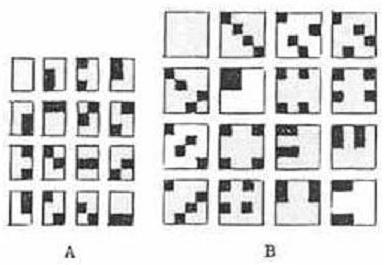
Salma Hayek
("Frida")

"Shinin' like a diamond
she had tombstones
in her eyes."

(For the above figures,
see Log24, 5/17/06,
"Tombstone," and
Log24, 9/13/03,
"For the Man in Black.")
and Keanu Reeves
("Constantine")
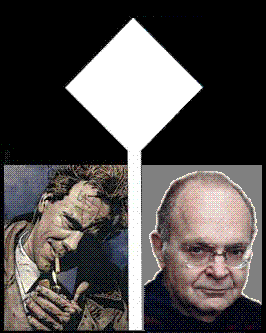
(For the above figure,
see Log24, 2/18/05,
"In Hoc Signo.")
Related material:
"Un cofre de gran riqueza
Hallaron dentro un pilar,
Dentro del, nuevas banderas
Con figuras de espantar."
"A coffer of great richness
In a pillar's heart they found,
Within it lay new banners,
With figures to astound."

For some further details, see
the brief Log24 narrative
"Indiana Jones and
the Hidden Coffer" as well as
Symmetry Framed and
the design of the doors
to Rick's Cafe Americain:

“Some friends of mine
are in this band.”
— David Auburn, Proof

“And if the band you’re in
starts playing different tunes
I’ll see you on
the dark side of the moon.”
— Quoted in Log24 on the
July 20, 2005, anniversary
of the 1969 Apollo 11
“one small step” moon landing
Last night’s entry on Glenn Ford, freemasonry, and the business of narrative leads to the following meditation.
This morning’s New York Times obituary of the Apollo 11 launch director brings back memories of Dean Martin’s classic refrain “when the moon hits your eye like a big pizza pie….” This in turn is a reminder of one of the great subtitles– Dino: Living High in the Dirty Business of Dreams (by Nick Tosches, published by Secker & Warburg on November 9, 1992). I respect the launch director, Rocco A. Petrone, who later headed the successful recovery of Apollo 13 (and also headed the entire Apollo program), but I also greatly respect Nick Tosches as a guide to the dark side of humanity. Secular humanism and the religion of scientism are all very well as cheerleaders for physics, but Tosches and the Roman Catholic Church have a much better understanding of human nature and original sin.
Powered by WordPress